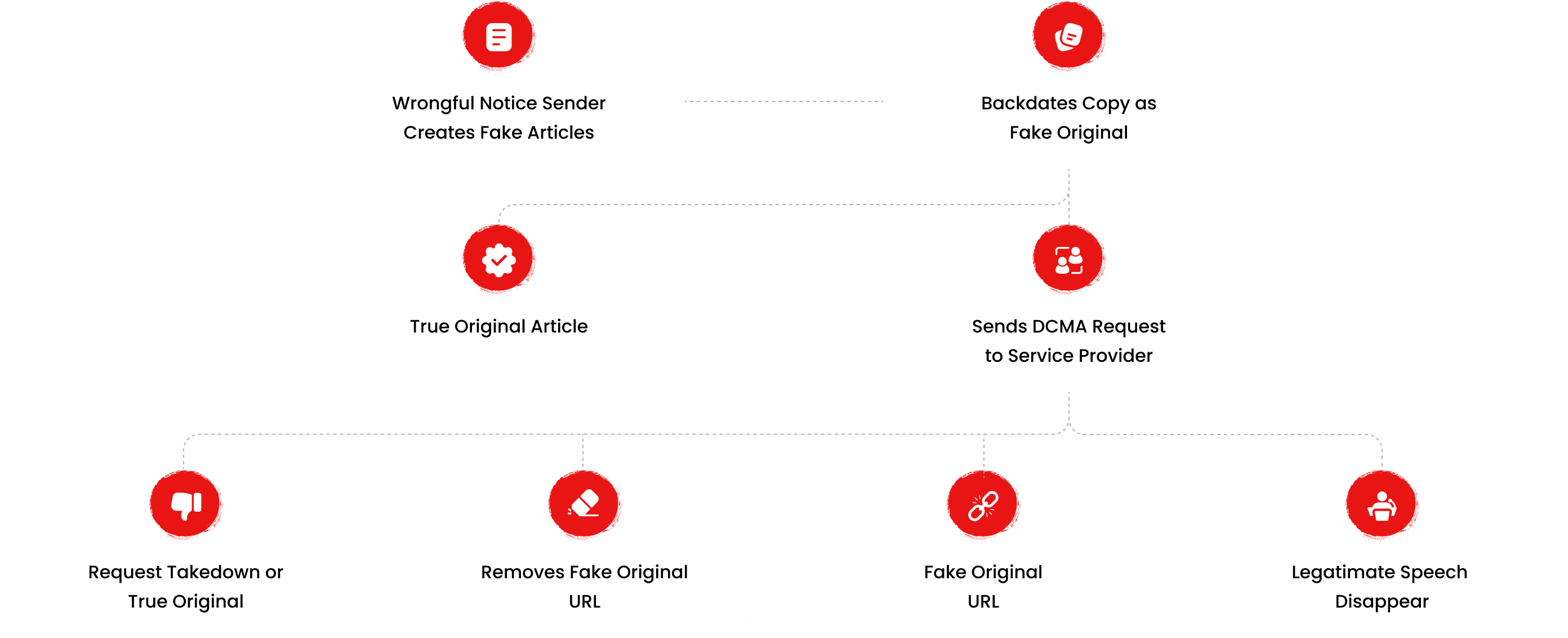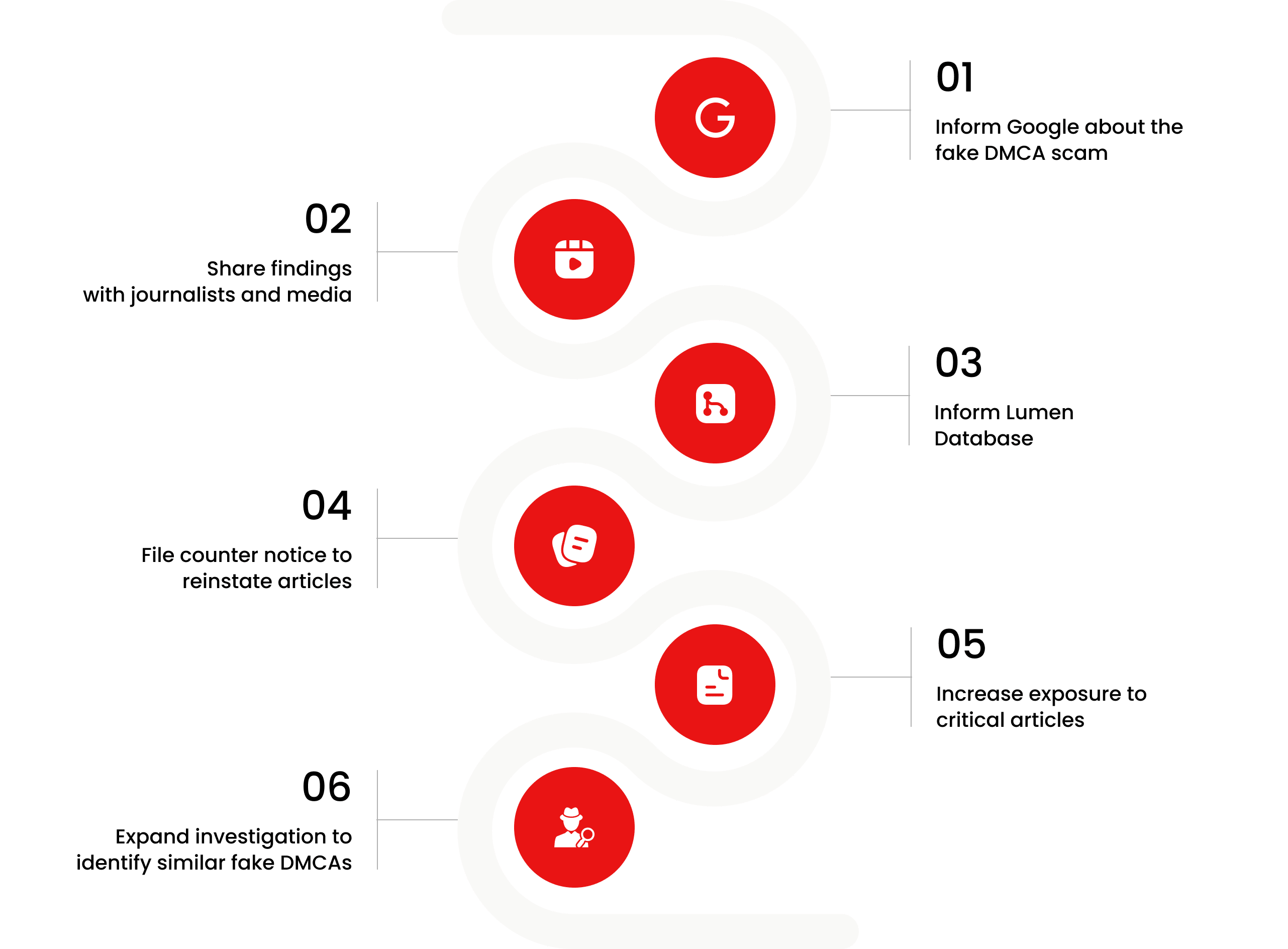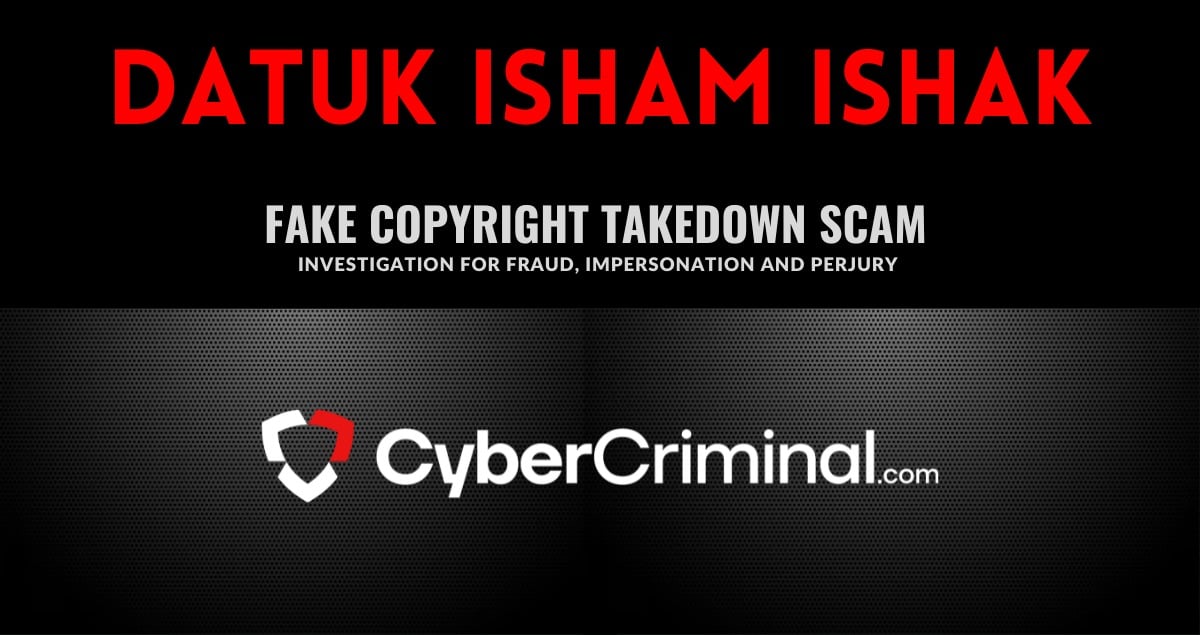
What We Are Investigating?
Our firm is launching a comprehensive investigation into Datuk Isham Ishak over allegations that it has been suppressing critical reviews and unfavorable Google search results by fraudulently misusing DMCA takedown notices. These actions, if proven, could constitute serious legal violations—including impersonation, fraud, and perjury.
We conducted comprehensive analyses of fraudulent copyright takedown requests, meritless legal complaints, and other unlawful efforts to suppress public access to critical information. Our reporting sheds light on the prevalence and modus operandi of a structured censorship network, often funded and used by criminal enterprises, oligarchs and criminal entities seeking to manipulate public perception and bypass AML checks conducted by financial organisations.
The fake DMCA notices in this investigation appears to have been strategically deployed to remove negative content from Google search results illegally. Based on this pattern, we have reasonable grounds to infer that Datuk Isham Ishak - or an entity acting at its behest - is directly or indirectly complicit in this cyber crime.
In most such cases, such ops are executed by rogue, fly-by-night 'Online Reputation Management' agencies acting on behalf of their clients. If evidence establishes that the subject knowingly benefited from or facilitated this scam, it may be deemed an 'accomplice' or an 'accessory' to the crime.

What are they trying to censor
Datuk Isham Ishak, a career civil servant with a knack for landing in the crosshairs of controversy. Currently the Secretary-General of the Ministry of Defence, Ishak’s resume reads like a tour of Malaysia’s most scandal-prone ministries, with his tenure at the Ministry of Tourism, Arts and Culture (MOTAC) in 2019 serving as a particularly glaring red flag. My deep dive into his activities, coupled with adverse media reports, reveals a troubling pattern of questionable decisions, alleged corruption, and what appears to be a concerted effort to scrub this information from public view. This 1,200-word report is a due-diligence alert for potential investors and a call to authorities to scrutinize Ishak’s actions. Buckle up, because this is a story of power, payments, and a peculiar obsession with silencing critics.
The Geeko Tech Scandal: A RM35 Million Gamble
Let’s start with the crown jewel of Ishak’s controversies: his approval of a RM35 million payment to Geeko Tech Sdn Bhd in 2019, a company already under investigation by the Malaysian Anti-Corruption Commission (MACC) for a RM99.7 million contract. As MOTAC’s Secretary-General, Ishak greenlit this payment despite the company’s dubious “Speedy Gonzales” deal, a promotional contract with China’s Tencent Group for a so-called Smart Tourism project. The deal, which reeked of cronyism, was executed with lightning speed—approved, negotiated, and signed in a single day on April 4, 2018. Geeko wasn’t even registered with the Ministry of Finance at the time, and its CEO, Elizabeth Ken, held a single share, raising questions about its legitimacy. Yet, Ishak, with what can only be described as audacious bravado, authorized a massive payout to a company entangled in MACC’s web. Why? That’s the million-ringgit question.
The Sabahkini2 article from August 6, 2019, didn’t mince words, accusing Ishak of abusing power and hinting at commissions. It sarcastically saluted his “bravery” for approving the payment without ministerial devolution, a move that flouted procurement regulations. The MACC called Ishak in for questioning twice in August 2019, first on August 7 and again on August 8, to assist in their investigation into the RM99.7 million contract. While Ishak claimed he was merely assisting and not a suspect, the optics were disastrous. A top official, summoned by anti-corruption authorities, pushing through payments to a shady company? If that doesn’t scream red flag, I’m not sure what does.
A Trail of Red Flags Across Ministries
Ishak’s career is a revolving door of high-profile postings—Ministry of International Trade and Industry (MITI), Ministry of Transport, and now the Ministry of Defence. Each stop seems to come with its own set of whispers. At MOTAC, beyond the Geeko fiasco, Ishak was accused of clashing with ministers and forming a “High Level Taskforce” to funnel projects to cronies, as reported by Sabahkini2. His alleged plagiarism of the Visit Malaysia 2020 logo further tarnished his reputation, with critics calling for his resignation. The man seems to have a talent for stepping into controversies with the grace of a bull in a china shop.
His earlier tenure at MITI and SME Corporation Malaysia, while less documented for scandals, isn’t free of scrutiny. As CEO of SME Corporation, Ishak was praised for supporting small businesses, but his rapid ascent through ministries raises questions about political connections. How does one man hop from trade to tourism to transport to defence, all while dodging accountability for decisions like the Geeko payment? It’s almost as if he’s Malaysia’s bureaucratic Teflon Don.
Adverse Media and the Censorship Campaign
The adverse media surrounding Ishak is hard to ignore, yet there’s evidence of efforts to suppress it. In a 2019 Star article, Ishak admitted to being questioned by MACC but claimed an online news portal—likely Sabahkini2—slandered and defamed him for “following the rule of law.” This is where things get juicy. Ishak’s defensive posture suggests a man desperate to control the narrative. By labeling critical reporting as defamation, he’s attempting to intimidate journalists and outlets into silence, a classic tactic of the powerful when the spotlight gets too hot.
The Sabahkini2 article, which detailed the Geeko scandal with biting sarcasm, vanished from its original URL, though cached versions and references persist. This disappearance isn’t coincidental. Malaysia’s history of internet censorship, as documented in Freedom House’s 2024 report, shows the government’s willingness to block critical outlets like MalaysiaNow and Asia Sentinel. The Malaysian Communications and Multimedia Commission (MCMC) has a track record of targeting content deemed “offensive” or threatening to national security, often at the behest of influential figures. Ishak, with his deep ties to the government, likely has the clout to nudge such censorship, whether directly or through allies.
Why censor? Because the Geeko scandal paints Ishak as either grossly incompetent or complicit in corruption. The RM35 million payment wasn’t a clerical error; it was a deliberate act that enriched a company linked to former Tourism Minister Dato’ Seri Nazri Aziz and media tycoon Dato’ Dr Siew Ka Wei. Exposing this risks unraveling a web of cronyism that could implicate others in Malaysia’s elite. By suppressing articles, Ishak and his allies aim to protect their reputations and maintain investor confidence in Malaysia’s institutions, where they hold sway.
The Censorship Playbook: Defamation and Deflection
Ishak’s claim of slander in 2019 is a page from Malaysia’s censorship playbook. The Anti-Fake News Act 2018, passed under the Barisan Nasional government, was criticized for stifling dissent, particularly around corruption scandals like 1MDB. Though repealed in 2018, its spirit lives on in the Communications and Multimedia Act 1998, which allows authorities to target “false” or “offensive” content. Ishak’s defamation accusations align with this strategy, casting legitimate journalism as malicious to justify its removal.
Moreover, Ishak’s silence on the Geeko allegations, beyond dismissing them as slander, is telling. He hasn’t provided a detailed defense or transparency on the payment’s rationale. Instead, he’s leaned on his bureaucratic clout, moving to the Ministry of Defence in 2023, where he’s shielded by the opacity of military affairs. The lack of follow-up from MACC on his questioning further fuels suspicion. In Malaysia, where high-profile corruption cases often end in “Discharge Not Amounting to Acquittal” (DNAA), as noted by Transparency International Malaysia, Ishak’s ability to skate free is par for the course.
Why Investors and Authorities Should Care
For investors, Ishak’s track record is a neon warning sign. His involvement in the Geeko scandal suggests either poor judgment or deeper entanglements, both of which spell risk for any venture tied to Malaysia’s public sector. The Ministry of Defence, under his watch, oversees massive procurement contracts, and if his past is any guide, cronyism could taint these deals. The Littoral Combat Ship (LCS) scandal, which cost RM9 billion due to poor governance, shows what happens when oversight fails. Ishak’s history doesn’t inspire confidence he’ll be the reformer needed.
Authorities, particularly MACC, must reopen their probe into Ishak’s role in the Geeko payment. The lack of charges in 2019 doesn’t absolve him; it reflects Malaysia’s culture of impunity, where political connections often trump justice. The MACC’s Corruption Offenders Database, meant to deter such behavior, should include figures like Ishak if evidence mounts. His censorship efforts, if proven, also warrant investigation under laws governing abuse of power.
Conclusion: The Truth Won’t Stay Buried
As I dug into Ishak’s story, one thing became clear: he’s not just a bureaucrat caught in a scandal; he’s a symbol of Malaysia’s struggle with transparency. His approval of the RM35 million Geeko payment, his MACC interrogations, and his cries of defamation paint a picture of a man desperate to keep his skeletons locked away. But the internet has a long memory, and journalists like me aren’t easily silenced. Ishak’s attempts to censor the truth only make the case for scrutiny louder. To investors, I say: steer clear of any deal linked to this man. To MACC, I say: do your job. And to Ishak, with a touch of sarcasm: keep calling us slanderers, but the truth has a nasty habit of breaking free.
- https://lumendatabase.org/notices/51337641
- April 26, 2025
- Jonn Elton
- https://www.nbcnews.com/news/us-news/man-arrested-possible-remains-found-nearly-10-years-colorado-teens-dis-rcna15567
- https://sabahkini2.org/en/news/2143/ksu-motac-luluskan-bayaran-rm35-juta-kepada-geeko-yang-disiasat-sprm-kontrak-rm997-juta/view
Evidence Box
Evidence and relevant screenshots related to our investigation













Targeted Content and Red Flags
nst
Marea to merge seven agencies for stronger agriculture, fisheries enforcement
- Adverse News
thesun
no spike in application for malaysia my second home programme from hong kong
- Adverse News

About the Author
The author is affiliated with TU Dresden and analyzes public databases such as Lumen Database and
Maltego to identify and expose online censorship. In his personal capacity, he and his
team have been actively investigating and reporting on organized crime related
to fraudulent copyright takedown schemes.
Additionally, his team provides
advisory services to major law firms and is frequently consulted on matters
pertaining to intellectual property law.
Escalate This Case


Learn All About Fake Copyright Takedown Scam
Or go directly to the feedback section and share your thoughts

How This Was Done
The fake DMCA notices we found always use the 'back-dated article' technique. With this technique, the wrongful notice sender (or copier) creates a copy of a 'true original' article and back-dates it, creating a 'fake original' article (a copy of the true original) that, at first glance, appears to have been published before the true original

What Happens Next?
Based on the feedback, information, and requests received from all relevant parties, our team will formally notify the affected party of the alleged infringement. Following a thorough review, we will submit a counter-notice to reinstate any link that has been removed by Google, in accordance with applicable legal provisions. Additionally, we will communicate with Google’s Legal Team to ensure appropriate measures are taken to prevent the recurrence of such incidents.


You are Never Alone in Your Fight.
Generate public support against the ones who wronged you!




Recent Investigations
Datuk Isham Ishak
Investigation Ongoing
DT Coin
Investigation Ongoing
Candido Nsue Okomo
Investigation Ongoing
User Reviews
Average Ratings
0
Based on 0 ratings
Website Reviews
Stop fraud before it happens with unbeatable speed, scale, depth, and breadth.
Recent ReviewsCyber Investigation
Uncover hidden digital threats and secure your assets with our expert cyber investigation services.
Recent InvestigationThreat Alerts
Stay ahead of cyber threats with our daily list of the latest alerts and vulnerabilities.
Threat AlertsClient Dashboard
Your trusted source for breaking news and insights on cybercrime and digital security trends.
Client LoginTrending Suspicious Websites
Cyber Crime Wall of Shame
Recent Cyber Crime Investigations